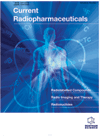- Home
- A-Z Publications
- Current Radiopharmaceuticals
- Previous Issues
- Volume 15, Issue 1, 2022
Current Radiopharmaceuticals - Volume 15, Issue 1, 2022
Volume 15, Issue 1, 2022
-
-
Head and Neck Cancer Treatments through Chemotherapy to Magnetic Systems: Perspectives and Challenges
More LessBackground: Cancer is one of the diseases causing society’s fears as a stigma of death and pain. Head and Neck Squamous Cell Carcinoma (HNSCC) is a group of malignant neoplasms of different locations in this region of the human body. It is one of the leading causes of morbidity and mortality in Brazil, because these malignant neoplasias, in most cases, are diagnosed in late phases. Surgical excision, chemotherapy an Read More
-
-
-
Mayapuri Radiological Catastrophe: Good Practices and the Lessons Learnt
More LessAuthors: Sandeep Sharma, Rakesh K. Sharma and Rajesh Kumar SinghBackground: Advances in the peaceful applications of ionizing radiation have brought in its wake the inevitable concern about radioactivity. Almost a decade ago, an infamous unprecedented radiological exposure incident occurred in Delhi, which has not only some positive aspects for imbibing good practices to emulate but also lessons learnt to further improvise the overall management, respectively. Objective: The Mayapuri in Read More
-
-
-
90Y-DOTA-Nimotuzumab: Synthesis of a Promising β− Radiopharmaceutical
More LessAuthors: Teresa Scotognella, Daria Maccora, Isabella Bruno, Marco Chinol, Massimo Castagnola, Francesco Collamati, Carlo Mancini-Terraciano, Silvio Morganti, Valerio Bocci, Elena S. Camillocci, Dante Rotili, Antonella Cartoni, Ilaria Fratoddi, Federica Marini, Iole Venditti, Riccardo Faccini and Alessandro GiordanoBackground: Nimotuzumab is a humanized anti-epidermal growth factor receptor (EGFR) monoclonal antibody, nowadays used for tumour immunochemotherapy. This study aimed to label the conjugate DOTA-nimotuzumab with yttrium-90, in order to provide a β- emitting radioimmunoconjugate (90Y-DOTA-nimotuzumab) potentially useful to assess the feasibility of a new radio-guided surgery approach. Me Read More
-
-
-
Automated Radiosynthesis and Molecular Docking Studies of Coumarin- Triazole Hybrid with fluorine-18: A feasibility study
More LessBackground: Fluorine-18 is one of the promising radiotracers that can report target specific information related to its physiology to understand the disease status through the PET modality. In the current study, the radiochemical synthesis, purification, and molecular docking studies of fluorine-18 (18F) radiolabeled coumarin-triazole hybrid have been performed. Objective: To develop target specific fluorine-18 radiotracer for th Read More
-
-
-
The Radiosensitizing Effect of Olanzapine as an Antipsychotic Medication on Glioblastoma Cell
More LessBackground: Radiotherapy is used as one of the most effective regimens for cancer treatment, while radioresistance is a major drawback in cancer treatment. Objectives: This study aimed to evaluate the sensitizing effect of olanzapine (OLA) with X-ray on glioblastoma (U-87 MG) cells death. Methods: The synergistic killing effect of OLA with ionizing radiation (IR) on glioma was evaluated by colony formation assay. The genera Read More
-
-
-
Investigation of Radiolabeling Efficacy by Enhancement of the Chemical form of no Carrier Added 177Lu Isolated by Electro Amalgamation Process
More LessBackground: Due to the suitable nuclear decay characteristics, 177Lu is an attractive radionuclide for various therapeutic applications. The non-carrier added form of177Lu has drawn much attention because of its high specific activity needed in radiolabeling studies. There have been several separation methods for NCA177Lu production. Objectives: Among the various separation methods, the electro-amalgamation separatio Read More
-
-
-
Feasibility of a Scale-down Production of [68Ga]Ga-NODAGA-Exendin-4 in a Hospital Based Radiopharmacy
More LessBackground: Glucagon-like peptide 1 receptor (GLP-1R) is preferentially expressed in β-cells, but it is highly expressed in human insulinomas and gastrinomas. Several GLP-1 receptor– avid radioligands have been developed to image insulin-secreting tumors or to provide a quantitative in vivo biomarker of pancreatic β-cell mass. Exendin-4 is a high affinity ligand of the GLP1- R, which is a candidate for being labeled with a PET i Read More
-
-
-
Detailed Chemistry Studies of 225Actinium Labeled Radiopharmaceuticals
More LessAuthors: Kurtulus Eryilmaz and Benan KilbasBackground: The synthesis of 225Actinium derivatives was afforded by using PSMA- 617, DOTATATE peptides, and EDTMP ligand. Detailed experiments, quality control (QC), and stability studies were also well described. The radiolabelling reactions were performed in mild conditions with desirable radiochemical yields and high radiochemical purities. Methods: PSMA-617, DOTATATE were radiolabelled with 225Actinium in 0 Read More
-
-
-
How does the Selection of Laboratory Mice Affect the Results of Physiological Distribution of Radiopharmaceuticals?
More LessAuthors: Urszula Karczmarczyk, Piotr Ochniewicz, Ewa Laszuk, Kamil Tomczyk and Piotr GarnuszekBackground: The choice of mice strain can significantly influence the physiological distribution and may lead to an inadequate assessment of the radiopharmaceutical properties. Objective: This work aims to present how the legal requirements that apply to radiopharmaceuticals contained in the various guidelines determine the choice of the mouse strain for quality control and preclinical studies and affect the results of physio Read More
-
Volumes & issues
Most Read This Month
Article
content/journals/crp
Journal
10
5
false
en


